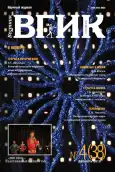Том 10, № 4 (2018)
- Год: 2018
- Статей: 18
- URL: https://journals.eco-vector.com/2074-0832/issue/view/868
- DOI: https://doi.org/10.17816/VGIK104
Весь выпуск
ХРОНИКА В ДЕТАЛЯХ | АКТУАЛЬНОЕ СОБЫТИЕ
«ДНИ ВГИК»: ЗАРУБЕЖНЫЕ МАРШРУТЫ
Аннотация
Международные связи ВГИК с вузами и национальными школами разных стран интенсивно развиваются. Подтверждением служит успешно завершившийся в Москве 38-й Международный студенческий кинофестиваль ВГИК, или "Студенческий “Оскар”, как его называет российская пресса.
В преддверии празднования 100-летнего юбилея прославленного российского вуза и 120-летия со дня рождения Сергея Эйзенштейна в фестивале участвовали будущие кинематографисты 38 киношкол из 36 стран, они представили на конкурсную программу 43 фильма.
Еще одно доказательство — проведение «Дней ВГИК», состоявшихся на исходе 2018 года в Республике Беларусь, Республике Узбекистан, Италии и Румынии. И везде делегацию ВГИК ждал теплый и радушный прием.
 6
6


ТЕОРИЯ И ИСТОРИЯ КИНО | ЭКРАННЫЕ ИСКУССТВА
Влияние шедевров мирового кино на творческое мировоззрение режиссера
Аннотация
В статье актуализируется одна из наиболее сложных проблем в искусствоведческих исследованиях - воздействие художественного шедевра на эмоциональное восприятие творческой личности, роль этого явления в процессе профессионального становления художника. Рассматривается взаимосвязь силы эстетического переживания киношедевра с художественным стилем мастера кино, значимость этого события в творчестве кинорежиссера. Анализ проблемы основан на материалах личных бесед автора статьи с выдающимися режиссерами отечественного кинематографа.
 8-23
8-23


ЧИТАЛЬНЫЙ ЗАЛ | КНИЖНАЯ ПОЛКА
Библиотека ВГИК
 24
24


КИНОЯЗЫК И ВРЕМЯ | ГЕНЕЗИС ОБРАЗА
Современное российское кино в контексте мирового
Аннотация
В статье предпринята попытка вписать параметры отечественного кинематографа последней четверти века в историю мирового киноискусства, соотнести доминирующие принципы и художественные методики, приводившие зачастую к сходным моделям и способам их воплощения. Работа ставит перед собой цель не просто выявить и описать компаративистские модели, но определить закономерности их возникновения и проявления, обусловленные историческими причинами.
 26-39
26-39


Образ провинции в российском кино 2000-х годов в фокусе гражданской идентичности
Аннотация
Новизна и актуальность статьи заключается в рассмотрении современных российских фильмов о провинции в ракурсе одной из главных задач государственной культурной политики - «укрепления гражданской идентичности». Анализируются фильмы 2000-х годов, которые не только затрагивают весьма острые вопросы различных видов идентификации российского общества, но и стимулируют процесс разрешения этих проблем.
 40-52
40-52


ПЕРФОРМАНС | ИСКУССТВО ВОПЛОЩЕНИЯ
Невольное поведение персонажей Гоголя
Аннотация
На примере произведений Н.В.Гоголя в статье приводится анализ литературных персонажей, выявляются сложности переноса художественного текста на экран, контекстуально уточняется несопоставимость эстетик книжного текста и кинематографа. Внимание акцентируется на психологических и поведенческих мотивах литературных героев, что особо значимо для творчества сценариста и режиссера, работающих с экранизацией литературных произведений.
 54-61
54-61


Трансформация архаического мифа и дискурс власти в фильме А.Сокурова «Молох»
Аннотация
Статья посвящена анализу трансформации мифа в творчестве А.Сокурова на примере фильма «Молох». В работе исследуется горная мифология в немецкой культуре и связывается с неомифологией, создаваемой в фильме А.Сокурова. Анализируются три ипостаси киновоплощения образа Молоха: Адольф Гитлер, нацистская идея и энтропия.
 62-68
62-68


Композиция как способ коммуникации при обучении изобразительному искусству
Аннотация
В условиях диверсификации художественных течений и школ студентам не всегда просто выбрать то или иное направление, что негативно отражается на учебном процессе, приводит к ослаблению контакта с преподавателем. В статье рассматривается проблема установления педагогического контакта с учениками, уточняется, что углубленное преподавание композиции как основы изобразительного искусства позволяет раскрыть будущим художникам тот фундамент, который должен быть освоен вне зависимости от избрания художественного направления в своем творчестве.
 69-77
69-77


Загадка как структурный элемент жанра «квест»
Аннотация
Одной из наиболее востребованных форм современной массовой культуры является жанр «квест», пред ставленный в разных форматах - от видеоигр и кинематографа до городских экскурсий и специально оборудованных игровых пространств. В чем секрет популярности этого формата, корни которого обнаруживаются еще в архаике, мифах и ритуалах? В статье обосновывается взаимосвязь жанра «квест» с литературой, кинематографом, видеоиграми, реалити-шоу. Феномен загадки в контексте «реальной виртуальности» не исследовался ранее в культурологическом аспекте, современные художественно-игровые формы только начинают осмысливаться в условиях цифровизации.
 78-87
78-87


ЧИТАЛЬНЫЙ ЗАЛ | КНИЖНАЯ ПОЛКА
Библиотека ВГИК
 88
88


КУЛЬТУРА ЭКРАНА | КУЛЬТУРОЛОГИЯ. ФИЛОСОФИЯ
Культура XVIII века: возвращение к человеку
Аннотация
На материале философских трудов Дж.Вико, Ж.-Ж.Руссо, Г.Гердера, И.Канта в статье анализируются типологические особенности культуры XVIII века, выявляется коренная переориентация всего культурного процесса с космологической идеи на идею антропологическую, приводятся гуманистические основания культуры и определение ее личностной формы, раскрывается осмысление человеком себя в качестве не объекта, а субъекта познания и творчества.
 90-102
90-102


Особенности философии искусства, эстетики и искусствоведения как научных дисциплин
Аннотация
В статье определяется специфика эстетики, философии искусства и искусствоведения. Описываются и анализируются как различие, существующее между этими дисциплинами, так и сходство, которое определяется общим предметом исследования. Утверждается, что уровень научной объективности философии искусства и эстетики выше, чем в искусствоведении, поскольку последнее менее свободно от оценочных суждений об искусстве, и в этом смысле более субъективно.
 103-114
103-114


МИРОВОЙ КИНОПРОЦЕСС | АНАЛИЗ
Влияние произведений Ф.Ведекинда на немецкий кинематограф начала XX века
Аннотация
Лулу, героиня литературных произведений Ф.Ведекинда, становится в немецком кинематографе 1920-х годов неврологической точкой эпохи, обозначившей смену морально-нравственных ориентиров в социуме, связанных с переоценкой гендерных ролей в обществе. За художественным образом Лулу скрывается возникшая в Европе на рубеже XIX–XX веков концепция «новой женщины», основанная на идее равноправия полов как базиса обновления общества и гармонизации мира. Через сравнительный анализ литературного первоисточника и фильма Г.В.Пабста «Ящик Пандоры» в статье исследуется экранная репрезентация этого образа.
 116-124
116-124


КИНОБИЗНЕС | СТРАТЕГИЯ И ТАКТИКА УПРАВЛЕНИЯ
Воздействие креативного контента на модификацию структуры кинопоказа в России
Аннотация
С учетом особенностей российской структуры кинопоказа в статье обосновывается широкий спектр основных направлений креативного контента, предназначенного для демонстрации в кинотеатрах. Рассматриваются также концептуально-структурные и экономические преимущества этой модели дистрибьюции кинопродукции, имеющей важное значение для отечественного кинобизнеса.
 126-137
126-137


ЧИTAЛЬHЫЙ ЗАЛ | КНИЖНАЯ ПОЛКА
 138
138


ТЕЛЕВИДЕНИЕ | ЦИФРОВАЯ СРЕДА
Визуальная картина мира в отражении современных медиа
Аннотация
На примере телевидения в статье рассматриваются проблемы отражения визуальной картины мира в современных медиа, приемы раскрытия множественности смыслов с помощью визуальности и телесности, способы воздействия на зрительское (чувственное) восприятие. Приводится сравнение понятий «правда экрана» и «правда жизни» в кино- и видеоконтенте. Анализ этих вопросов позволяет по-новому проследить процесс поиска выразительности экранной культуры, включая внеэкранный медиаконтент и арт-проекты.
 140-151
140-151


SUMMARY | ПРЕЗЕНТАЦИЯ АВТОРОВ
Презентация авторов
 152-157
152-157


РЕКОМЕНДАЦИИ АВТОРАМ
Рекомендации авторам
 158-160
158-160













